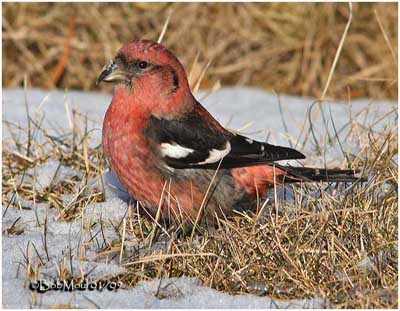
White-winged Crossbill
Loxia leucoptera
Passeriforme Order – Fringillidae Family
BIOMETRICS:
Length : 15-17 cm
Wingspan : 26-27 cm
Weight : 24-26 g
LONGEVITY : up to 4 years
DESCRIPTION :
Male and female are quite different in plumage, and there are important colour’s variations.
White-winged Crossbill adult male has bright pink body plumage. Wings are black with white-tipped tertials, and two conspicuous white wing bars. Tail is black. A broad black band crosses the back.
On the underparts, lower belly and undertail coverts are buffy-white. Flanks are brownish-grey. Underparts are pinkish, slightly streaked whitish.
Plumage is paler in winter.
Head is pink as body. Lores are blackish, and we can see a black crescent on the head sides.
The blackish bill is strong, down-curved, with crossed tips. It is very well adapted for extracting the seeds from the cones.
Eyes are dark brown to black. Legs and feet are blackish.

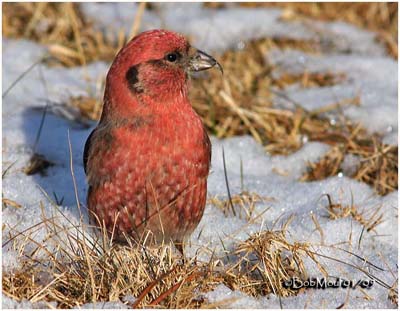
Female shows similar plumage pattern, but she has greenish body, mottled with yellowish-olive to greyish-green. The rump is pale yellow.
Underparts are greyish-olive, finely streaked with dark grey. Breast and body sides are tinged yellow.
Head is yellowish-olive, finely mottled with dark grey.
Wings and tail are similar to those of male.
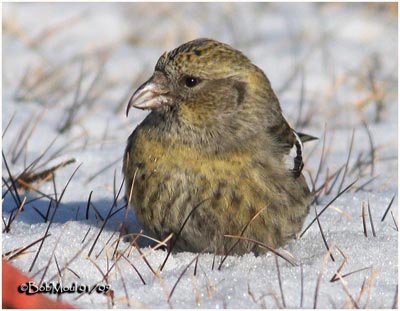

Juvenile resembles female but duller, with heavily streaked plumage overall. The wing bars are narrower than in adults.
VOICE: SOUNDS BY XENO-CANTO
White-winged Crossbill’s call is a dry “kip-kip-kip”. But we can also hear a liquid “peet” and series of harsh “chet-chet-chet”.
The song is a series of trills mixed with harsh rattles and melodious warbles. Song may be uttered during the flight displays.
HABITAT:
White-winged Crossbill frequents coniferous forests with spruce trees, where it finds its preferred food. It may be found in deciduous trees too, such as birches or rowans. It is typically observed in boreal forests.
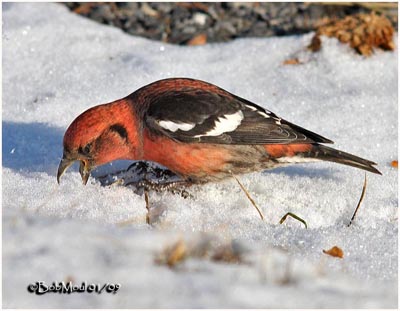
RANGE:
White-winged Crossbill is often resident from central Alaska to Newfoundland, and southwards to the northern parts of the United States.
This species also occurs across northern Eurasia.
In winter, it remains in the breeding range, but it may perform some movements according to the food resources.
BEHAVIOUR:
White-winged Crossbill is very nomadic, and wanders in large flocks throughout its northern range.
This bird feeds mainly on spruce seeds. Thanks to the crossed mandibles, it is able to open the cones and to extract the seeds.
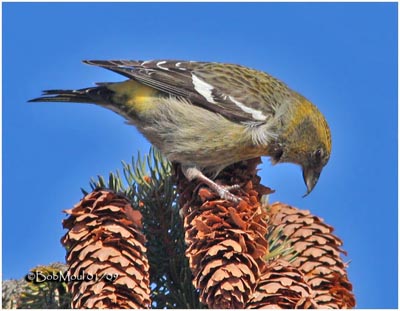
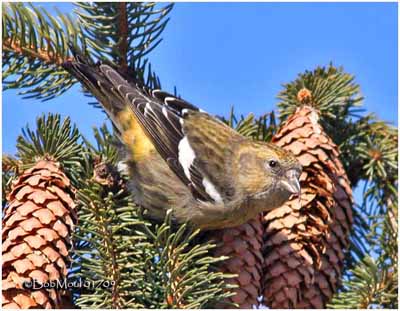
It hangs on the cones and then, the bill holds the scale of the cone open, while it reaches the seed with the tongue. It may consume great numbers of seeds, about 3000 per day! It starts at the bottom of the cone and spirals upwards.
This species can store seeds in the throat where there is a “pocket” at middle level.

White-winged Crossbill is also attracted by salt on the roads in winter.
The pair forms within the group, and this species is monogamous. Male performs flight displays while singing.
FLIGHT:
White-winged Crossbill performs swift undulating flight with rapid wing beats.
REPRODUCTION:
Breeding season is closely related to the food resources. This species can breed all the year if the sources of seeds are abundant.
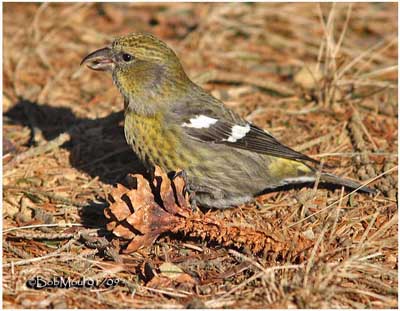
The nest is placed in a spruce tree on horizontal branch.
It is an open cup built by female. It is made with twigs, weeds, grass, bark strips, and the interior is lined with finer materials such as lichen, moss, rootlets and hair.
Female lays 2 to 4 eggs. Incubation lasts about 12 to 14 days, by female. The male feeds her during this period.
At hatching, chicks and female are fed by the male, but after five days, both parents bring food at nest.
Young leave the nest about 18 to 22 days after hatching. Male care them after fledging, while female starts a second clutch.
The mandibles of the young begin to cross about two weeks after fledging, and then, they have to learn how to use the bill for feeding!

DIET:
White-winged Crossbill feeds mainly on spruce seeds, but it also takes seeds of other coniferous species such as tamarack. This bird also consumes seeds from weeds and grasses, and insects.
PROTECTION / THREATS / STATUS:
White-winged Crossbill populations are not globally threatened. Numbers may increase in some areas, according to the food resources.
Fr: Bec-croisé bifascié
All : Bindenkreuzschnabel
Esp: Piquituerto Franjeado
Ital: Crociere fasciato
Nd: Witband kruisbek
Russe: Белокрылый клест
Sd: Bändelkorsnäbb
Photographs by Bob Moul
His website :
Nature Photography
Text by Nicole Bouglouan
Sources :
FIELD GUIDE TO THE BIRDS OF NORTH AMERICA by National Geographic Society - National Geographic Society - ISBN: 0792274512
THE HANDBOOK OF BIRD IDENTIFICATION FOR EUROPE AND THE WESTERN PALEARCTIC by Mark Beaman, Steve Madge - C.Helm - ISBN: 0713639601
All About Birds (Cornell Lab of Ornithology)
Bird Web (Seattle Audubon Society)
Birds of Nova Scotia (Robie Tufts)
What Bird-The ultimate Bird Guide (Mitchell Waite)
Wikipedia (Wikipedia, The Free Encyclopedia)